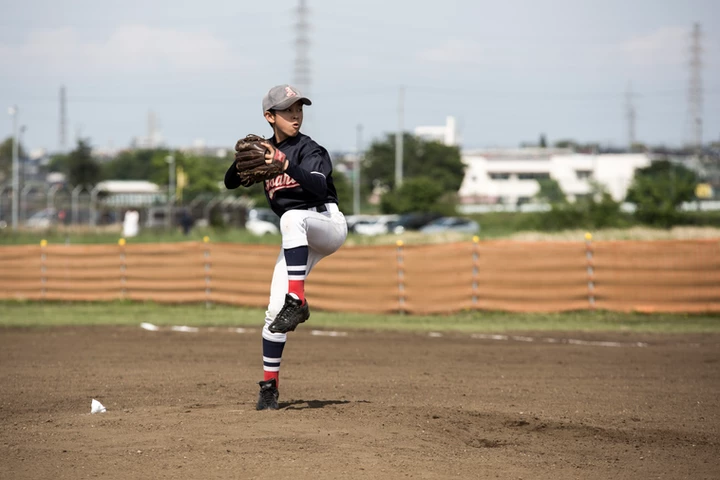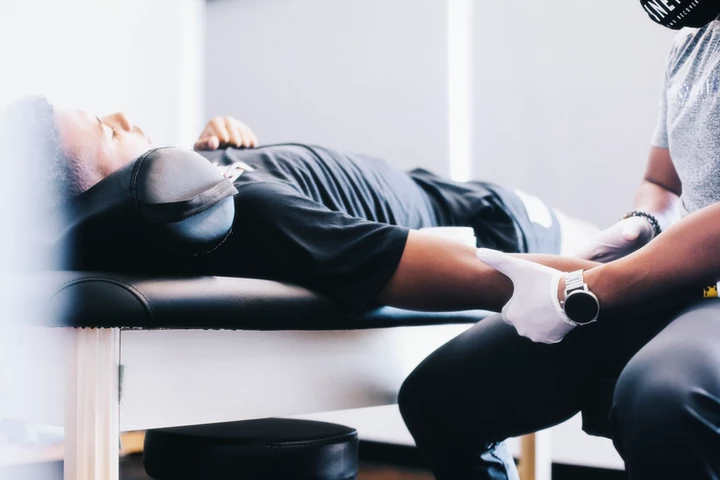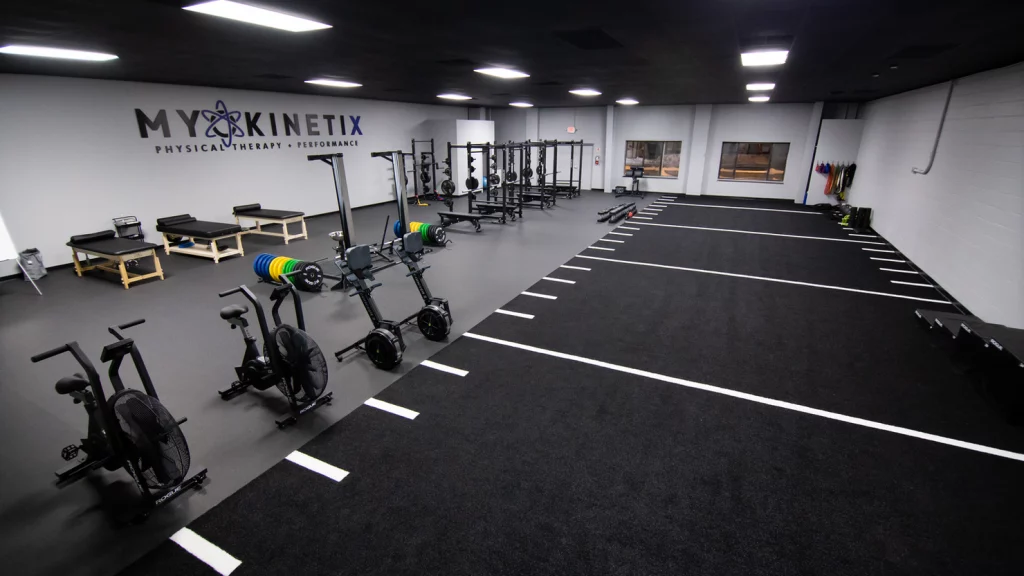- Why elbow injuries in baseball and softball are common due to repetitive stress during overhead motions, especially in pitchers, resulting from overuse and poor throwing mechanics.
- What is the basic anatomy of the elbow joint, including its three bones (humerus, ulna, and radius), and the role of the Ulnar Collateral Ligament (UCL)?
- How proper conditioning, emphasis on skills and technique, and adequate recovery between games can help reduce the risk of elbow injuries in young athletes.
Whether you’re a concerned parent who’s looking for treatment options for your athlete or trying to figure out why your child is in pain, you’re in the right place.
Today’s article covers the most common elbow injuries in baseball and softball, and what you should expect in terms of recovery for your young athlete.
Without further ado, let’s dig in.
Why Do Elbow Injuries in Baseball Occur?
Some athletes are prone to upper-body injuries due to the demands of their sport. As overhead athletes, baseball and softball players tend to place a significant amount of stress on their elbows, and several throws over a short period of time can lead to overuse injuries.
In particular, pitchers are most commonly affected by elbow pain from baseball, due to the fact that they repeat the same motion over and over again. If a pitcher is experiencing elbow pain, then it is likely a direct result of these things:

- # of pitches thrown
- # of innings pitched
- # of months pitched throughout the year
Parents, you should also be aware that bigger and taller pitchers, as well as kids who compete at a higher level – aka, those who are pitching at fast speeds and playing in highly competitive baseball leagues – are more prone to elbow injuries or elbow pain than others who do not fall into these categories.
Understanding Common Elbow Injuries of a Throwing Athlete
In order to have a better understanding of common elbow injuries of a throwing athlete, it’s important to know the basic anatomy of the elbow joint.
The joint is made up of three bones: the humerus (upper arm), the ulna (which runs along the pinky side of the forearm), and the radius (found on the thumb side). Probably the most well-known part of the elbow is the olecranon of the ulna, which is that bony part that sticks out and is commonly called, “the funny bone.”
Together, these three bones allow the forearm to do three motions: bend, straighten, and rotate.
It’s crucial to realize that the elbow is home to many soft tissues that provide stability to the joint. On the inside, (medial) side of the elbow, is the Ulnar Collateral Ligament (UCL), which runs from the humerus to the ulna and supports the elbow during overhead motion.
Now that you have a better grasp of the anatomy of the elbow, let’s get into the specifics of the most common elbow injuries in baseball.
1. Flexor Tendinitis
Among the many muscles of the forearm, elbow pain in baseball mostly impacts the flexor and pronator muscles. The flexor muscles bend the elbow, while the pronator muscles are what make the elbow rotate inward (as if you’re placing your palm down on a table).
Flexor tendinitis is associated with inflammation of the flexor muscles, which are located on the inside of the elbow. Athletes who perform repetitive overhead actions, like throwing in baseball, are more prone to suffer from flexor tendonitis, and will usually get inner elbow pain before and after throwing.
Typically, treatment is a conservative approach with rest, ice, and over-the-counter non-steroidal anti-inflammatory drugs (NSAIDs) to reduce inflammation.
2. Ulnar Neuritis
Although not considered to be part of the elbow, the ulnar nerve crosses behind the elbow joint and controls the hand muscles.
Multiple throws can lead to stretching, snapping, and slipping of the ulnar nerve. These undue stresses on the ulnar nerve cause it to become inflamed and angry.
Here are some of the common signs and symptoms associated with ulnar neuritis:
- Shocking sensation
- Numbness below the elbow
- Tingling below the elbow
- Pain in pinky and ring fingers
Ulnar neuritis treatment sees a fair amount of success with conservative (nonsurgical) intervention. This usually involves ice, NSAIDs, and activity modification. Sometimes, the use of a night splint for anywhere from 6-9 weeks is recommended, especially if your athlete loves to sleep curled up in the fetal position.
If conservative treatment fails, then surgery may be recommended. Rest assured, surgery for ulnar neuritis is typically conducted with high success rates and an uncomplicated 12-week recovery with rehabilitation.
3. Ulnar Collateral Ligament (UCL) Injury
The act of throwing places a great amount of stress on the ulnar collateral ligament and, as a result, this structure is commonly injured in baseball. UCL injuries can be characterized as overuse or traumatic in nature, with the severity of injury ranging from minor inflammation of the ligament to a complete tear. Baseball players, particularly pitchers, find this to be the most frequent cause of their elbow pain.
Signs and symptoms associated with a UCL injury are:
- Pain during and after throwing
- Pain prior to ball release
- Numbness or tingling in the pinky and ring fingers
- In traumatic cases, a noticeable pop on the inside of the elbow
Immediate management of non-traumatic UCL injury should be conservative. The typical recommendation includes six weeks of rest with a strengthening of the forearm flexors and pronators. In order to return to throwing, your athlete needs to be symptom-free with a normal physical exam. The timeline for return is anywhere from 3-6 months, depending on the severity of the injury.
Should surgery be recommended, the return is approximately 9-12 months. Surgical intervention is generally necessary for traumatic cases of UCL injuries, which is most often seen in young adults who play competitive baseball or softball.
A word of caution: ulnar neuritis is usually present alongside a UCL injury. In these cases, when surgical intervention is the plan of action, an ulnar nerve transposition will be performed along with the UCL repair.
4. Valgus Extension Overload (VEO)
In most cases of elbow pain or injury, there is increased stress on the inside of the elbow, known as valgus stress. Poor throwing mechanics, such as rotating the trunk too late in the pitching motion, lack of external rotation at the shoulder joint, or increased elbow flexion can all directly cause this type of stress on the elbow.
Repetitive stress applied to the outside of the elbow, referred to as valgus stress, can lead to the protective cartilage on the olecranon wearing away. If left untreated, this can further lead to the development of bony growths, known as bone spurs or osteophytes. This condition is known as valgus extension overload (VEO).
During the throwing motion, the olecranon and the humerus meet when the arm is fully straightened. The repeated trauma of the two bones colliding together is the root cause of VEO.
With VEO, baseball athletes will have elbow pain on the back side of the joint with possible swelling. Additionally, your athlete may be able to feel a bony bump if bone spurs are present. These bone spurs can be located on the back side or the inside of the elbow, depending on the area in which the olecranon and humerus see the most contact when the arm is straightened.
Conservative treatment is effective in most cases and includes the following recommendations:
- Rest
- Throwing restrictions
- Interval throwing program (allows a gradual return to pitching)
- Corrected pitching mechanics
5. Medial Apophysitis
Chronic inflammation that affects the growth plate is commonly referred to as “little leaguer’s elbow.” Most often, your young one will have pain or a knobby bump on the inside of the elbow.
Little leaguer’s elbow occurs when there is an excessive amount of tension on the tendons and ligaments of the elbow. If the tension is severe enough, then the tendons and ligaments can pull away from the bone, much like the way a plant takes the soil when it is uprooted. Be warned, this scenario disrupts normal bone growth and can result in permanent deformity.
Parents, it’s important to realize that certain pitches, like a curveball and breaking pitches, may make your athlete slightly more prone to stressors on the inside of the elbow. Therefore, it may be best to encourage other skills until he/she is a little older.
The mainstay of treatment for little leaguer’s elbow is a conservative, non-operative approach. A period of complete rest from throwing for 4-6 weeks is strongly encouraged, followed by a strengthening and endurance program to maintain cardiovascular fitness and overall core strength. Oftentimes, these young athletes have poorly-developed core strength and neuromuscular control that increases their risk for poor throwing mechanics and injury.
Following rest, a structured return-to-throwing program should be progressed by experts who are highly specialized in treating little leaguer’s elbow.
6. Olecranon Stress Fracture
Among all the elbow injuries in the throwing athlete, olecranon stress fractures are most commonly seen in the younger population. This is due to the fact that your young athlete is still growing and his or her body has not yet fully developed.
Symptoms of olecranon stress fractures are similar to that of VEO, and the pain is most noticeable when the arm is fully straightened. Because VEO and olecranon stress fractures present similarly, imaging is needed to differentiate between the two diagnoses.
Treatment is almost always nonsurgical, however, in rare cases, surgery may be necessary. Usually, symptoms improve with rest and temporary splinting, and a gradual return to pitching can begin.
Unfortunately, recovery from a stress fracture takes a little longer than some of the other elbow injuries and can last up to six months. However, it’s important that your athlete is pain-free before being allowed to return to throwing and pitching.
Takeaway points
Due to the repetitive nature of the sport, elbow pain from baseball is bound to be experienced by most athletes. Add poor throwing mechanics to the equation, and overuse injuries are almost inevitable. Luckily, proper conditioning, emphasis on skills and technique, and adequate lengths of recovery between games can lessen your athlete’s risk of elbow injuries and pain.
Due to the nature of elbow injuries, you should make it a priority to find experts who know how to conduct a proper evaluation and examination of your athlete’s weaknesses and abilities. Doing this is crucial to determine the extent of the injury and, therefore, recovery time.

If you’re in the East Hanover area, then look no further than the specialists at Myokinetix Physical Therapy. Our doctors of physical therapy are experts in sports rehabilitation, especially when working with young athletes and overhead sports. Come check out our programs, and learn why athletes and their parents only trust us to get them safely back on the field.


Is it possible that the emphasis on early specialization in youth sports is contributing to the prevalence of little leaguer’s elbow and other throwing-related injuries in young athletes?
Definitely! It often occurs as an overuse injury, especially in kids who solely focus on one sport since there is no variety in their movements!